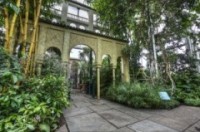New York’s Very Own Garden of Eden
Spanish Paradise: Gardens of the Alhambra exhibit at the New York Botanical Garden, showing until August 21, is an exhibit for the mind, eyes, ears, heart, nose, hands and feet — so prepare to be stimulated in every way.
From poetry, flamenco dancing and art to lectures, concerts, tastings and demonstrations, the exhibit is an educating force and a pleasure all at the same time. As Director of Exhibitions and Seasonal Displays, Karen Daubmann said, “It’s a multisensory exhibition. We really try to do it all.”
Daubmann stresses that the Alhambra of Spain, built in the 14th century and functioning as both a fortress and a palace, could not be replicated in New York.
“The climate is different than ours. But what we do here is give people a taste. And the feeling and the essence of the Alhambra –there’s so many buildings, and fountains, and plants; we take snippets and we put them together in a way that works for our space,” Daubmann clarified.
Indeed – it works. The mixing of worlds, cultures and traditions that one imagines when picturing the Alhambra is translated into the Gardens of New York, which is perfect for the most diverse city in the world.
“We love that people who’ve been to the Alhambra come here and rekindle that spirit within themselves. They say it’s different. Sometimes they say it’s better. A lot of people tell me they’ve been to the Alhambra and they haven’t seen as much in the ways of the color,” Daubmann explained.
“Every single day we change our plants and make sure they look their best. Other people are probably just curious; they may never make it to Spain in their lifetime, but they’re curious to come to the garden and see how we present the Alhambra and they also really enjoy that we have the components of the history and the poetry and the culture.”
In fact, the union of the poetry and the gardens is the most striking part of the exhibit. Featuring the poetry of Federico Garcia Lorca, the most translated Spanish poet and playwright in history and who is widely associated with the Alhambra, takes the execution of bringing a taste of the Alhambra to New York even further.
Lorca himself loved to dress up as a Moor and stroll through the Alhambra, paying homage to Spain’s pre-Christian past. He felt that coming from the region of Grenada, where the Moors and the Jewish peoples were persecuted so harshly, had made him who he was. In Grenada today, there is now a tradition to put on a Lorca play every year in the Gardens, and through it, keep both his legacy and history alive.
The Botanical Garden, in conjunction with the Poetry Society of America, is keeping it alive as well.
“He has such a broad amount of work,” Daubmann explained motioning toward where the poems are being featured. “Listening to the audio tours, they can gain a greater understanding of who he was, what he wrote about, what he believed in.”
From the birth of the idea to the actual fruition of it, the process took about two years. The plants in the exhibit were mostly grown on site and in the greenhouses. The exhibit was designed so that just as in the Alhambra in Spain, visitors to the Alhambra exhibit in New York can enjoy it at night, and even relish in a cocktail or two as they do it.
The exhibit is called Spanish Paradise. When we think Paradise, aside from the religious connotations, we often picture a Garden of Eden-like space, and as New Yorkers, we are very removed from that. We live in a city of skyscrapers where seeing open space is often a spiritual feat. What this exhibit proudly achieves is bringing the idea of paradise as a connection to nature. For those of us who feel very removed from it and who get our nature fix from Central Park, the colors and the smells of the gardens of the Alhambra, the sensation of being able to reach out and touch a citrus tree or a fig tree feels like magic. As Daubmann puts it, “I think that the New York Botanical Garden is Paradise.”
As the saying goes, a picture is worth a million words. But a stroll through Spanish Paradise: Gardens of the Alhambra is worth a million more, so go out there and experience it for yourself.
For more information on the exhibit and visiting hours please visit http://www.nybg.com/


